Type 2 solutions of radom fuzy wave equantion under generalized hukuhara diferntiability
In this paper, random fuzzy wave equations under generalized Hukuhara
differentiability are considered. By utilizing the method of successive approximations, the
existence, uniqueness and the continuous dependence on the data of type 2 random fuzzy
solutions of problem are proven. The most difficulty in this research is not only
depending on the concepts of fuzzy stochastic processes, which deeply depends on the
measurable properties of setvalued multivariable functions, but also depending on
calculation with gH-derivatives of multivariable. When we overcome these obstacles, the
gained random fuzzy solutions have decreased length of their values, which is more
significant to model many systems in the real world.
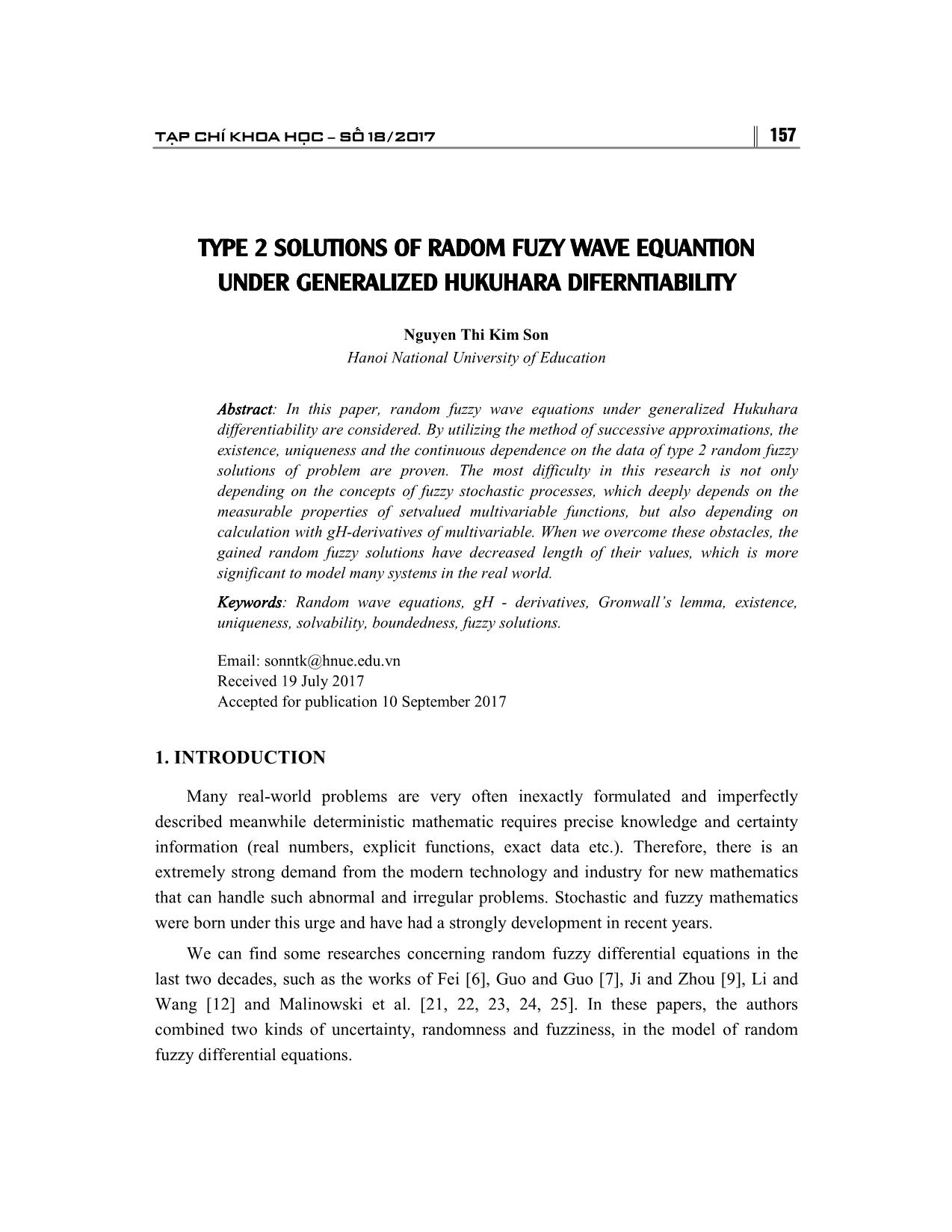
Trang 1
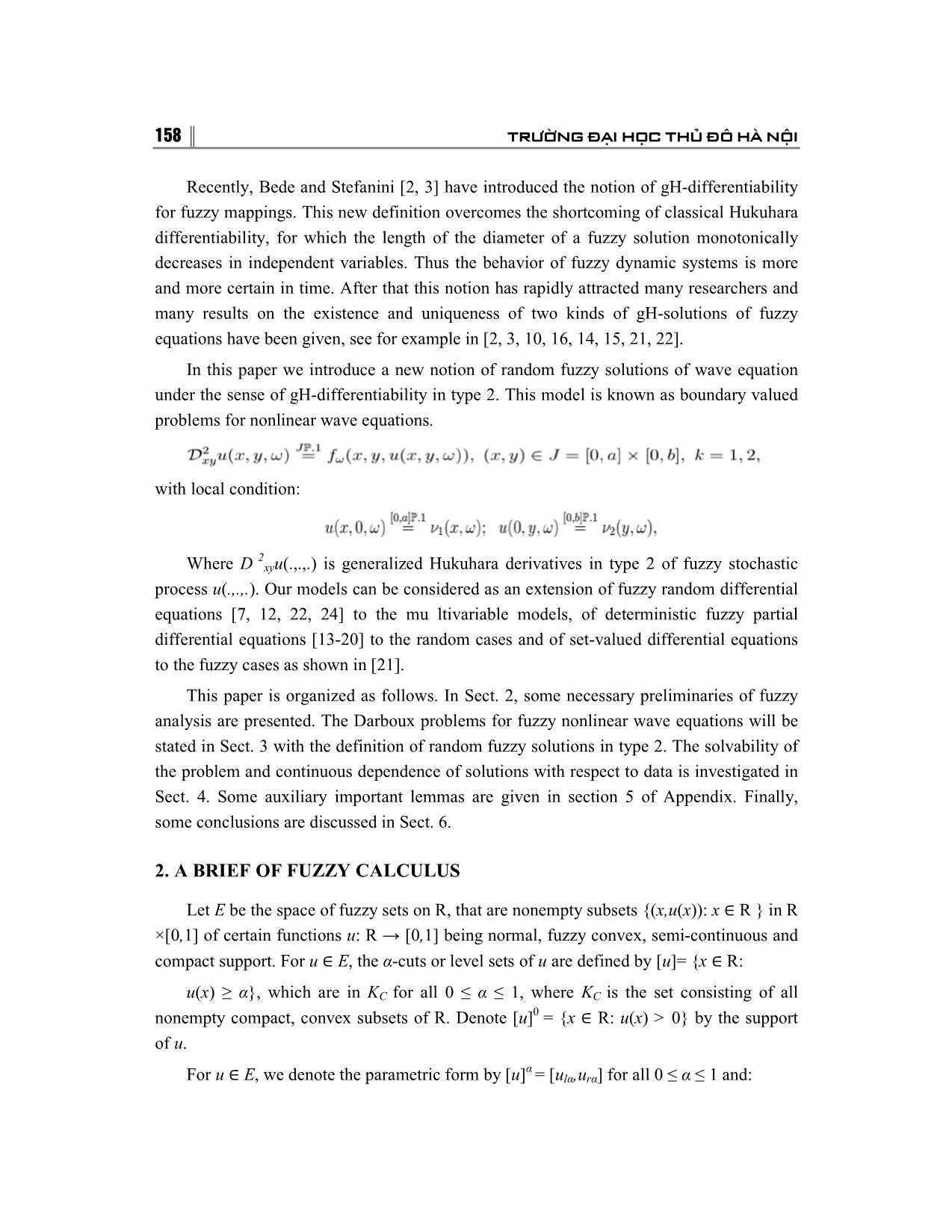
Trang 2
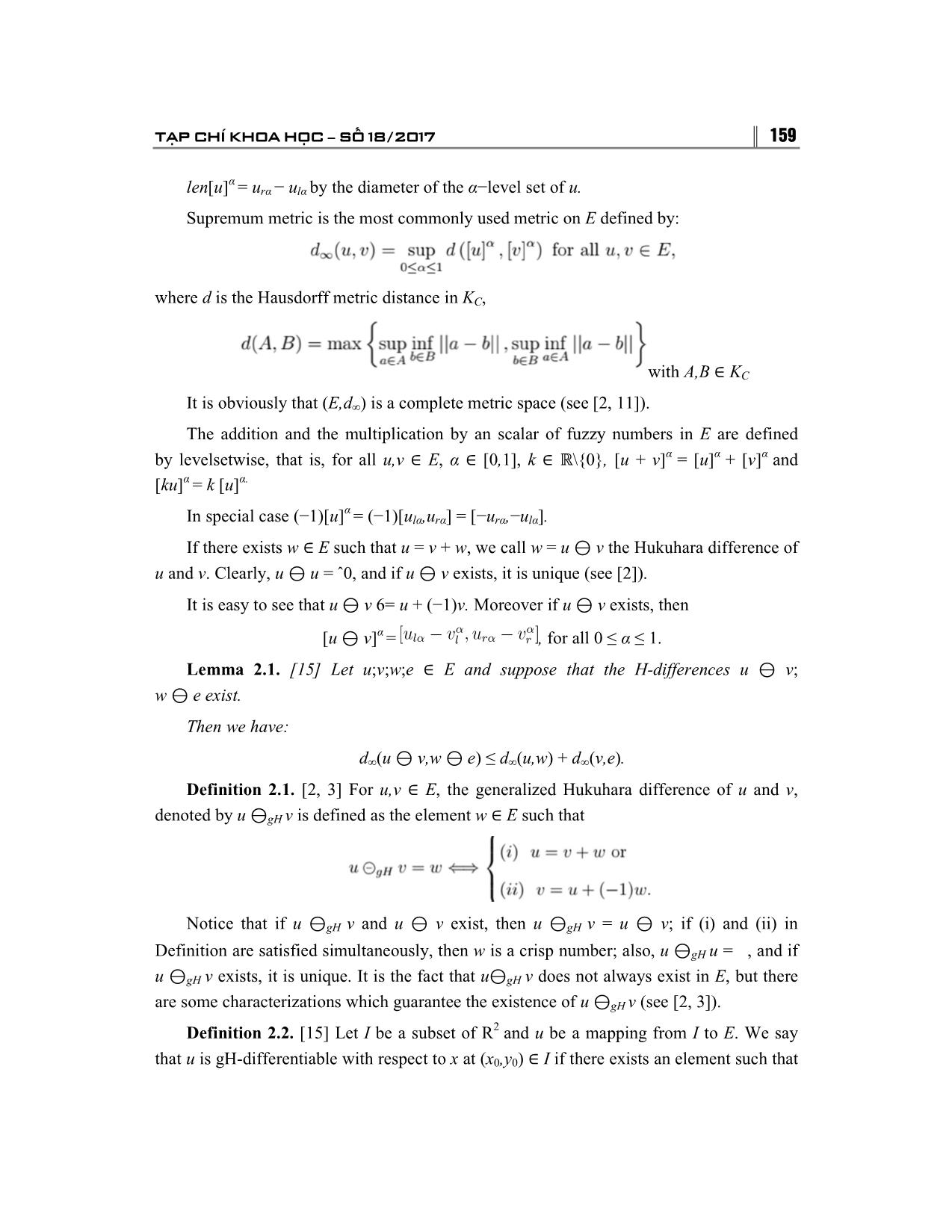
Trang 3
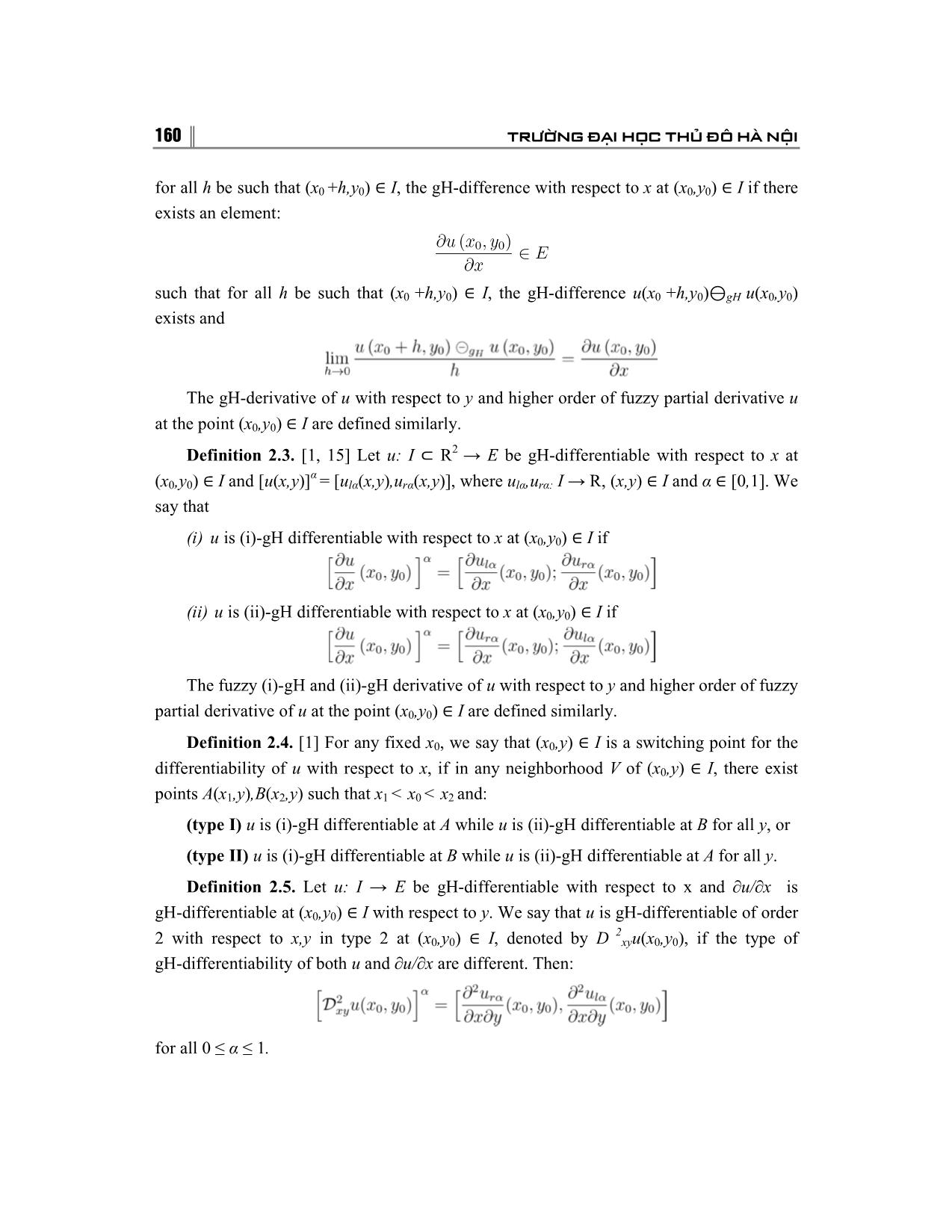
Trang 4
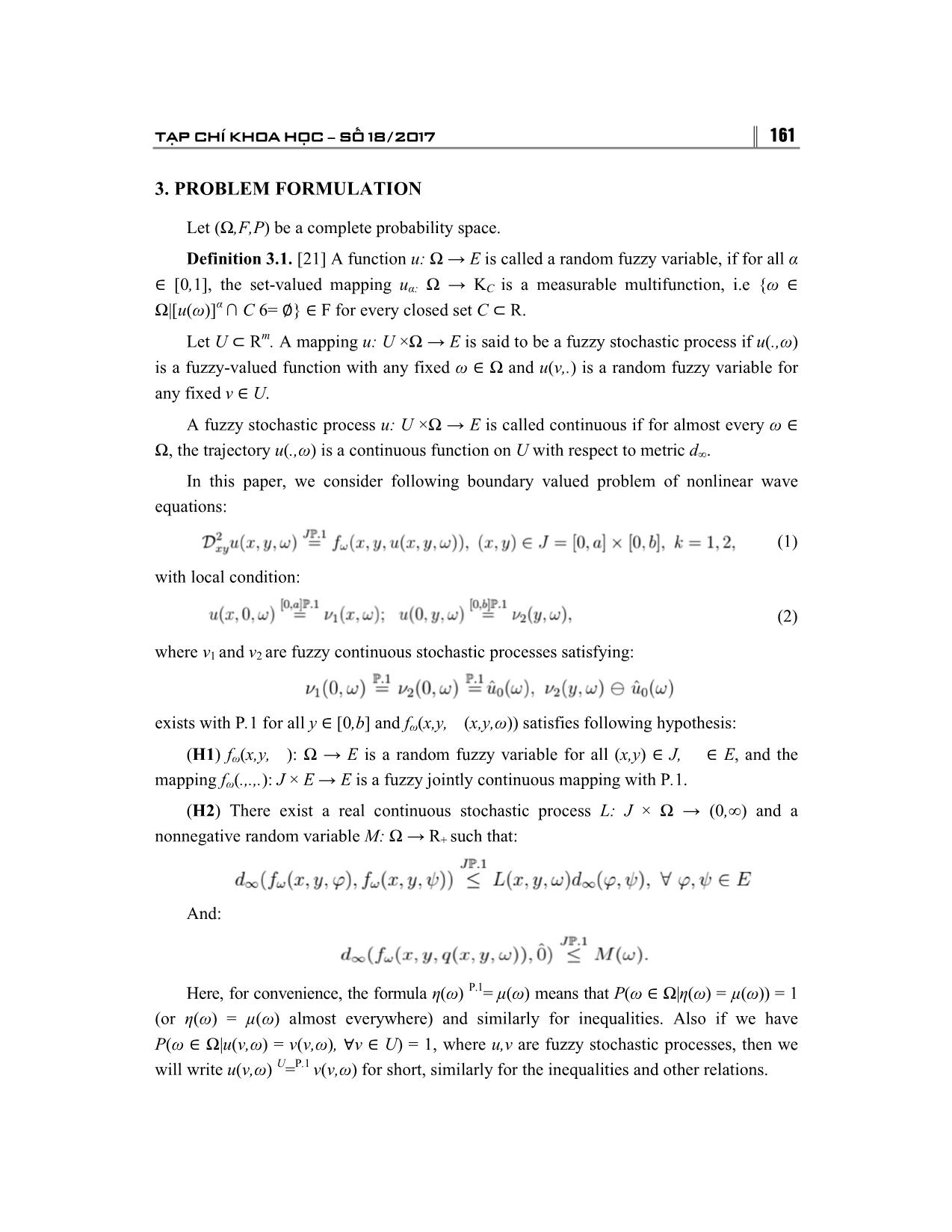
Trang 5
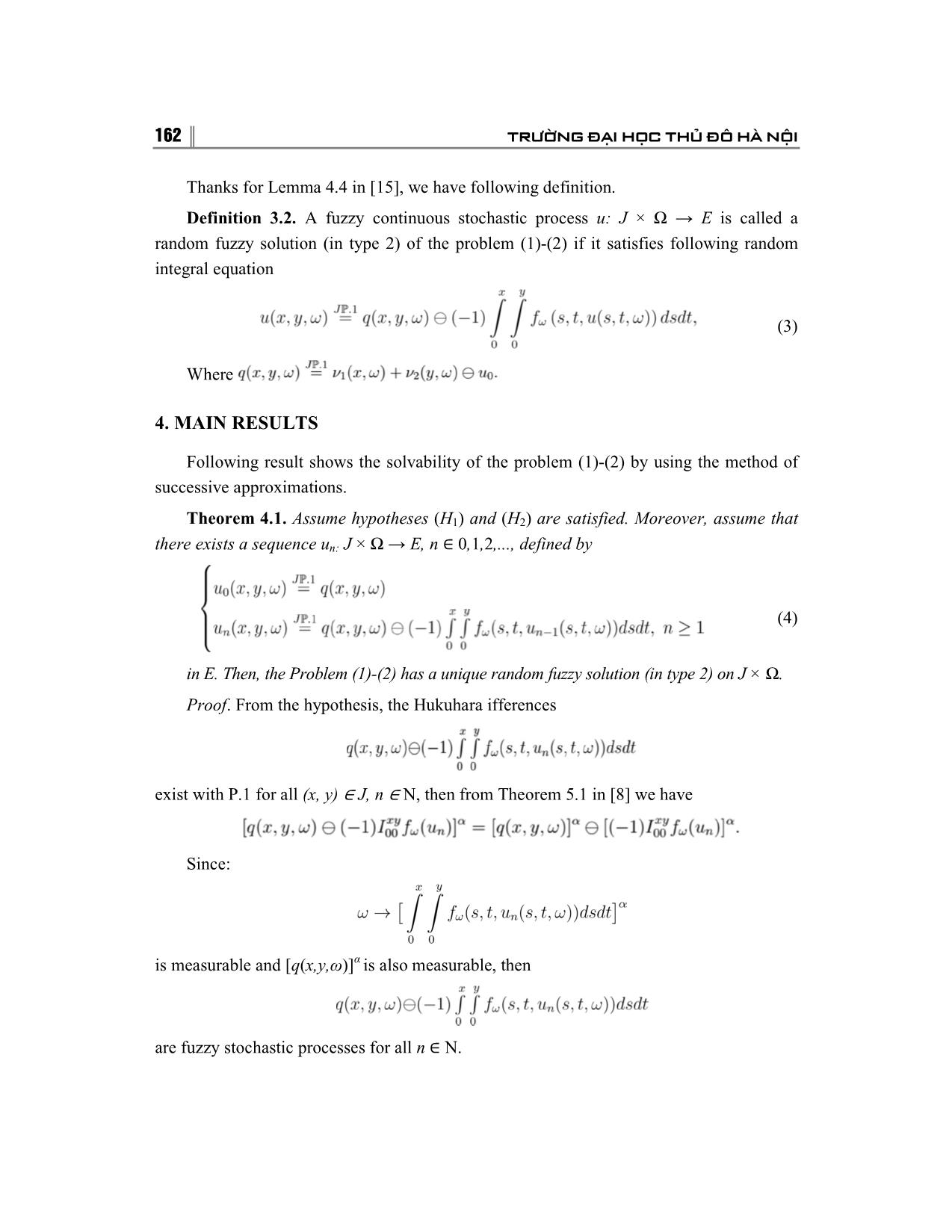
Trang 6
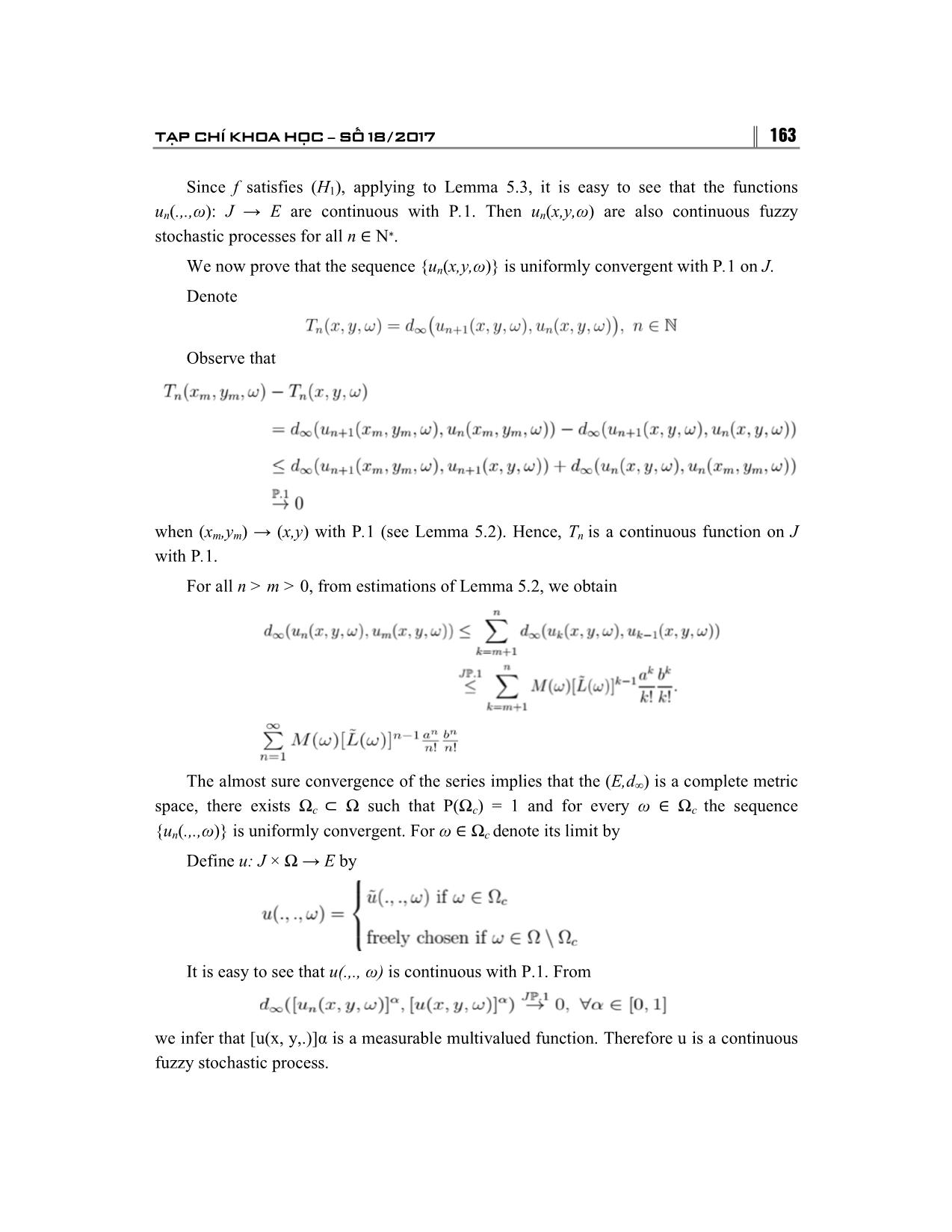
Trang 7
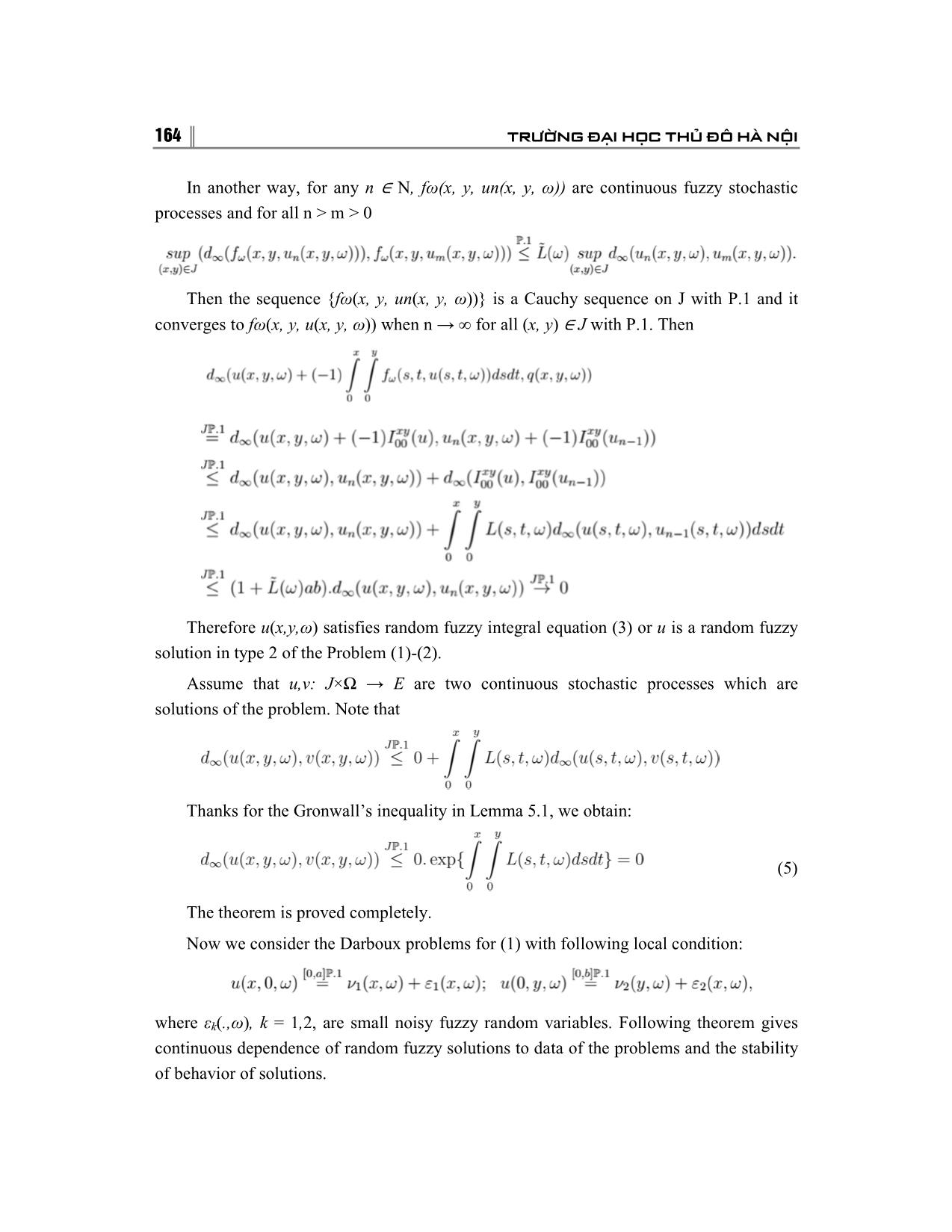
Trang 8
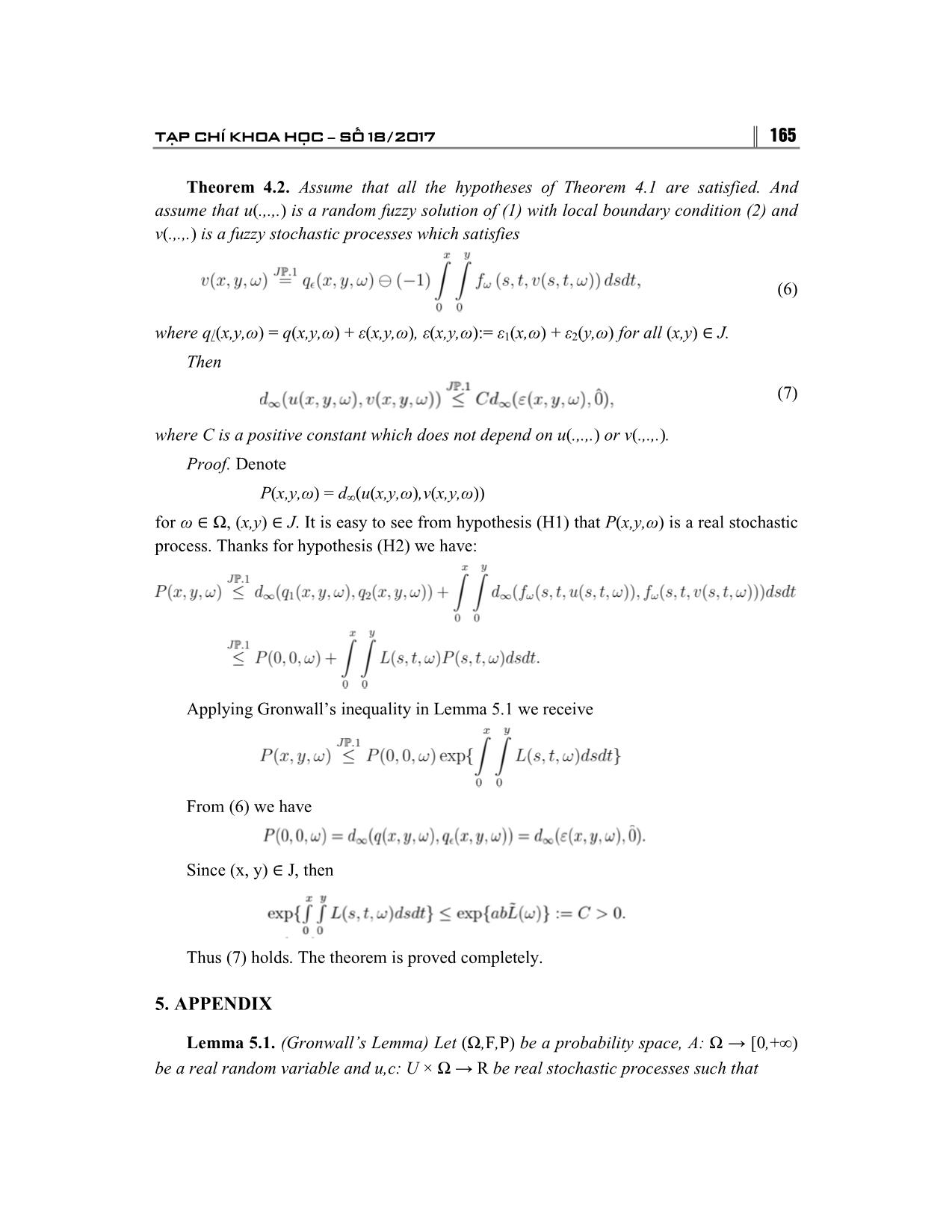
Trang 9

Trang 10
Tải về để xem bản đầy đủ
Tóm tắt nội dung tài liệu: Type 2 solutions of radom fuzy wave equantion under generalized hukuhara diferntiability
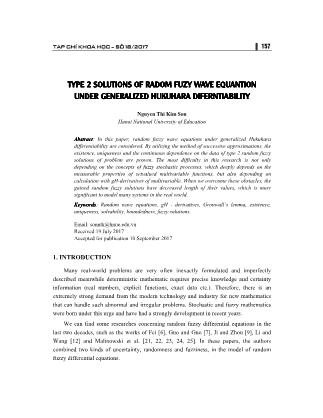
) ∈ I if
(ii) u is (ii)�gH differentiable with respect to x at ( x0,y 0) ∈ I if
The fuzzy (i)�gH and (ii)�gH derivative of u with respect to y and higher order of fuzzy
partial derivative of u at the point ( x0,y 0) ∈ I are defined similarly.
Definition 2.4. [1] For any fixed x0, we say that ( x0,y ) ∈ I is a switching point for the
differentiability of u with respect to x, if in any neighborhood V of ( x0,y ) ∈ I, there exist
points A(x1,y ),B (x2,y ) such that x1 < x 0 < x 2 and:
(type I) u is (i)�gH differentiable at A while u is (ii)�gH differentiable at B for all y, or
(type II) u is (i)�gH differentiable at B while u is (ii)�gH differentiable at A for all y.
Definition 2.5. Let u: I → E be gH�differentiable with respect to x and ∂u/∂x is
gH�differentiable at ( x0,y 0) ∈ I with respect to y. We say that u is gH�differentiable of order
2
2 with respect to x,y in type 2 at ( x0,y 0) ∈ I, denoted by D xy u(x0,y 0), if the type of
gH�differentiability of both u and ∂u/∂x are different. Then:
for all 0 ≤ α ≤ 1 .
TẠP CHÍ KHOA HỌC −−− SỐ 18/2017 161
3. PROBLEM FORMULATION
Let ( �,F,P) be a complete probability space.
Definition 3.1. [21] A function u: � → E is called a random fuzzy variable, if for all α
∈ [0 ,1], the set�valued mapping uα: � → K C is a measurable multifunction, i.e { ω ∈
�|[ u(ω)] α ∩ C 6= ∅} ∈ F for every closed set C ⊂ R.
Let U ⊂ Rm. A mapping u: U ×� → E is said to be a fuzzy stochastic process if u(.,ω )
is a fuzzy�valued function with any fixed ω ∈ � and u(ν,. ) is a random fuzzy variable for
any fixed ν ∈ U.
A fuzzy stochastic process u: U ×� → E is called continuous if for almost every ω ∈
�, the trajectory u(.,ω ) is a continuous function on U with respect to metric d∞.
In this paper, we consider following boundary valued problem of nonlinear wave
equations:
(1)
with local condition:
(2)
where ν1 and ν2 are fuzzy continuous stochastic processes satisfying:
exists with P.1 for all y ∈ [0 ,b ] and fω(x,y, (x,y,ω )) satisfies following hypothesis:
(H1 ) fω(x,y, ): � → E is a random fuzzy variable for all ( x,y ) ∈ J, ∈ E, and the
mapping fω(.,.,. ): J × E → E is a fuzzy jointly continuous mapping with P.1.
(H2 ) There exist a real continuous stochastic process L: J × � → (0 ,∞) and a
nonnegative random variable M: � → R+ such that:
And:
Here, for convenience, the formula η(ω) P.1 = �(ω) means that P(ω ∈ �| η(ω) = �(ω)) = 1
(or η(ω) = �(ω) almost everywhere) and similarly for inequalities. Also if we have
P(ω ∈ �| u(ν,ω ) = v(ν,ω ), ∀ν ∈ U) = 1, where u,v are fuzzy stochastic processes, then we
will write u(ν,ω ) U=P.1 v(ν,ω ) for short, similarly for the inequalities and other relations.
162 TRƯỜNG ĐẠI HỌC THỦ ĐÔ H� NỘI
Thanks for Lemma 4.4 in [15], we have following definition.
Definition 3.2. A fuzzy continuous stochastic process u: J × � → E is called a
random fuzzy solution (in type 2) of the problem (1)�(2) if it satisfies following random
integral equation
(3)
Where
4. MAIN RESULTS
Following result shows the solvability of the problem (1)�(2) by using the method of
successive approximations.
Theorem 4.1. Assume hypotheses (H1) and (H2) are satisfied. Moreover, assume that
there exists a sequence u n: J × � → E, n ∈ 0,1,2,..., defined by
(4)
in E. Then, the Problem (1)�(2) has a unique random fuzzy solution (in type 2) on J × �.
Proof . From the hypothesis, the Hukuhara ifferences
exist with P.1 for all (x, y) ∈ J, n ∈ N, then from Theorem 5.1 in [8] we have
Since:
is measurable and [ q(x,y,ω )] α is also measurable, then
are fuzzy stochastic processes for all n ∈ N.
TẠP CHÍ KHOA HỌC −−− SỐ 18/2017 163
Since f satisfies ( H1), applying to Lemma 5.3, it is easy to see that the functions
un(.,.,ω ): J → E are continuous with P.1. Then un(x,y,ω ) are also continuous fuzzy
stochastic processes for all n ∈ N∗.
We now prove that the sequence { un(x,y,ω )} is uniformly convergent with P.1 on J.
Denote
Observe that
when ( xm,y m) → ( x,y ) with P.1 (see Lemma 5.2). Hence, Tn is a continuous function on J
with P.1.
For all n > m > 0, from estimations of Lemma 5.2, we obtain
The almost sure convergence of the series implies that the (E,d ∞) is a complete metric
space, there exists �c ⊂ � such that P(�c) = 1 and for every ω ∈ �c the sequence
{un(.,.,ω )} is uniformly convergent. For ω ∈ �c denote its limit by
Define u: J × � → E by
It is easy to see that u(.,., ω) is continuous with P.1. From
we infer that [u(x, y,.)]α is a measurable multivalued function. Therefore u is a continuous
fuzzy stochastic process.
164 TRƯỜNG ĐẠI HỌC THỦ ĐÔ H� NỘI
In another way, for any n ∈ N, fω(x, y, un(x, y, ω)) are continuous fuzzy stochastic
processes and for all n > m > 0
Then the sequence { fω (x, y, un (x, y, ω ))} is a Cauchy sequence on J with P.1 and it
converges to fω (x, y, u (x, y, ω )) when n → ∞ for all ( x, y ) ∈ J with P.1. Then
Therefore u(x,y,ω ) satisfies random fuzzy integral equation (3) or u is a random fuzzy
solution in type 2 of the Problem (1)�(2).
Assume that u,v: J×� → E are two continuous stochastic processes which are
solutions of the problem. Note that
Thanks for the Gronwall’s inequality in Lemma 5.1, we obtain:
(5)
The theorem is proved completely.
Now we consider the Darboux problems for (1) with following local condition:
where εk(.,ω ), k = 1 ,2, are small noisy fuzzy random variables. Following theorem gives
continuous dependence of random fuzzy solutions to data of the problems and the stability
of behavior of solutions.
TẠP CHÍ KHOA HỌC −−− SỐ 18/2017 165
Theorem 4.2. Assume that all the hypotheses of Theorem 4.1 are satisfied. And
assume that u (.,.,. ) is a random fuzzy solution of (1) with local boundary condition (2) and
v(.,.,. ) is a fuzzy stochastic processes which satisfies
(6)
where q (x,y,ω) = q(x,y,ω) + ε(x,y,ω), ε(x,y,ω):= ε1(x,ω) + ε2(y,ω) for all (x,y ) ∈ J.
Then
(7)
where C is a positive constant which does not depend on u (.,.,. ) or v (.,.,. ).
Proof. Denote
P(x,y,ω) = d∞(u(x,y,ω),v (x,y,ω))
for ω ∈ �, ( x,y ) ∈ J. It is easy to see from hypothesis (H1) that P(x,y,ω ) is a real stochastic
process. Thanks for hypothesis (H2) we have:
Applying Gronwall’s inequality in Lemma 5.1 we receive
From (6) we have
Since (x, y) ∈ J, then
Thus (7) holds. The theorem is proved completely.
5. APPENDIX
Lemma 5.1. (Gronwall’s Lemma) Let (�,F,P) be a probability space, A: � → [0 ,+∞)
be a real random variable and u,c: U × � → R be real stochastic processes such that
166 TRƯỜNG ĐẠI HỌC THỦ ĐÔ H� NỘI
a) u(� ,�,ω ) is nonnegative and continuous with P.1 on U;
b) c(� ,�,ω ) is nonnegative, locally Lebesgue integrable on U with P.1;
c) furthermore following inequality hold
(8)
Then we have:
(9)
Proof. Let for ( x,y ) ∈ U.
From (8) we have:
is nonnegative with P.1 then v(.,.,ω ) is nonde��creasing in each variable x,y and v(0 ,y,ω ) =
A(ω). We have:
Therefore:
It follows:
TẠP CHÍ KHOA HỌC −−− SỐ 18/2017 167
Or:
Thus:
It completes the proof of this lemma.
Lemma 5.2. Suppose that hypotheses (H1) and (H2) are satisfied. Following
estimations hold for all n ≥ 1
(10)
where u n(.,.,ω ): J → E, n ≥ 0 are defined by (4) and
Proof. Denote
By mathematical induction, we will prove (10) for every n ≥ 1. In fact, we observe that
Moreover,
168 TRƯỜNG ĐẠI HỌC THỦ ĐÔ H� NỘI
Thus (10) is true for n = 1. Now, we assume that the inequality (10) is true for any
n ≥ 1. We will prove that it is also true for n + 1. Indeed
Therefore (10) holds for all n + 1, the proof is completed.
Lemma 5.3. Under hypotheses (H1) and (H2), un(.,.,ω ): J → E, n ≥ 0 defined by (4)
are continuous on J with P.1.
Proof. Indeed, u0(x,y,ω ) is natural continuous on J. Fixed ( x,y ) ∈ J, consider an
arbitrary sequence {( xm,y m)} that converges to ( x,y ) as m → ∞. For fixed
, there are four cases happening.
Case 1. When x < x m, y < y m, one has following presentation
(11)
TẠP CHÍ KHOA HỌC −−− SỐ 18/2017 169
Case 2. If x ≥ xm, y ≥ ym then
Case 3. If x < x m, y ≥ ym then
(12)
Case 4. If x ≥ xm, y < y m then
Now for n ≥ 1, from presentation (11) in Case 1, we have
(13)
From the hypothesis (H2) and the inequality (10) in Lemma 5.2 we have
(14)
Therefore
170 TRƯỜNG ĐẠI HỌC THỦ ĐÔ H� NỘI
Do the same arguments to the second and the third items of (13), we receive following
estimates for all n ∈ N∗
(15)
Now we consider Case 3: x < x m,y ≥ ym. Using presentation (12) we have:
(16)
for all n ∈ N.
Repeating all the arguments in (15) and (16) for Case 2 and Case 4, we receive the
same estimations. Now let ( xm,y m) tends to ( x,y ) then | x − xm|,|y − ym| tend to zero, too. It
implies from (15) and (16) that for every n ∈ N, functions un(.,ω ): J → E are continuous
with P.1.
6. CONCLUSION
Random fuzzy local boundary valued problems for partial hyperbolic equations are
studied under gH�differentiability. We prove the existence and uniqueness of random fuzzy
solutions in type 2. The uniqueness here is understood that each considering solution does
not have switching points. The method of successive approximations is used instead of
applying the frequently used fixed point method, which were applied in [13]�[20]. This
research provides the foundations for the further studying on the asymptotic behavior of
random fuzzy 135 solutions of partial differential equations.
TẠP CHÍ KHOA HỌC −−− SỐ 18/2017 171
REFERENCES
1. T. Allahviranloo, Z. Gouyandeh, A. Armand, A. Hasanoglu (2015), “On fuzzy solutions for heat
equation based on generalized Hukuhara differentiability”, Fuzzy Sets Syst . 265, pp.1�23.
2. B. Bede (2013), “Mathematics of Fuzzy Sets and Fuzzy Logic”, Springer�Verlag Berlin Heidelberg .
3. B. Bede and L. Stefanini (2013), “Generalized differentiability of fuzzy�valued functions”, Fuzzy Sets
Syst . 230, pp.119�141.
4. C. Castaing, M. Valadier, Lecture Notes in Mathematics (1997), “Convex Analysis and Measurable
Multifunctions”, Springer�Verlag Berlin Heidelberg NewYork.
5. V. Durikovic (1968), “On the uniqueness of solutions and the convergence of successive
approximations in the Darboux problem for certain differential equations of the type uxy = f(x,y,u,u x,u y)”,
Archivum Mathematicum . 4, pp.223�235.
6. W. Fei (2007), “Existence and uniqueness of solutions for fuzzy random differential equations with
non�Lipschitz coefficients”, Inf. Sci . 177, pp.4329�4337.
7. R. Guo and D. Guo (1009), “Random fuzzy variable foundation for Grey differential equation
modeling”, 150 Soft Comput . 13(2), pp.185�201.
8. N.T. Hung (1978), “A note on the extension principle for fuzzy set”, J. Math. Anal. Appl . 64, pp.369�
380.
9. X. Ji, J. Zhou (2015), “Multi�dimensional uncertain differential equation: existence and uniqueness of
solution, Fuzzy Optim”. Decis. Mak . 14(4), pp.477�491.
10. A. Khastan, J.J. Neito, R. (2014), “Rodr´ıguez�L´opez, Fuzzy delay differential equations under
generalized differentiability, Inf. Sci. 275, pp.145�167.
11. V. Lakshmikantham and R.N. Mohapatra (2003), “Theory of Fuzzy Differential Equations and
Inclusions” , Taylor and Francis Publishers, London
12. J. Li and J. Wang (2012), “Fuzzy set�valued stochastic Lebesgue integral”, Fuzzy Sets Syst . 200, pp.48�64.
13. H.V. Long, N.K. Son, N.M. Ha, L.H. Son (2014), “The existence and uniqueness of fuzzy solutions for
hyperbolic partial differential equations”, Fuzzy Optim. Decis. Mak . 13(4), pp.435�462.
14. H.V. Long, N.T.K.Son, N.V. Hoa (2017), “Fuzzy fractional partial differential equations in partially
ordered metric spaces”, Iran. J. Fuzzy Syst . 14, pp.107�126.
15. H.V. Long, N.K. Son, H.T. Tam (2015), “Global existence of solutions to fuzzy partial hyperbolic
functional differential equations with generalized Hukuhara derivatives”, J. Intell. Fuzzy Syst . 29(2),
pp.939�954.
16. H.V. Long, N.K. Son, H.T. Tam (2017), “The solvability of fuzzy fractional partial differential
equations under Caputo gH�differentiability”, Fuzzy Sets Syst . 309, pp.35�63.
17. [17] H.V. Long, N.K. Son, H.T. Tam, B.C. Cuong (2014), “On the existence of fuzzy solutions for
partial hyperbolic functional differential equations”, Int. J. Comp. Intell. Syst . 7(6), pp.1159�1173.
18. H.V. Long, N.K. Son, R.R. Lopez (2017), “Some generalizations of fixed point theorems in partially
ordered metric spaces and applications to fuzzy partial differential equations”, Vietnam Journal of
Mathematics , in press.
172 TRƯỜNG ĐẠI HỌC THỦ ĐÔ H� NỘI
19. H.V. Long, J.J. Nieto, N.T.K. Son (2017), “New approach to study nonlocal problems for differential
systems and partial differential equations in generalized fuzzy metric spaces”, Fuzzy Sets Syst .,
20. H.V. Long, N.T.K Son, H.T.T. Tam and J�C. Yao (2017), “Ulam stability for fractional partial integro�
differential equation with uncertainty”, Acta Mathematica Vietnamica , DOI: 410.1007/s40306�017�
0207�2.
21. M.T. Malinowski, R.P. Agarwal (2015), “On solutions to set�valued and fuzzy stochastic differential
equations, J. Franklin Institute 352(8), pp.3014�3043.
22. M.T. Malinowski (2015), “Random fuzzy fractional integral equations � theoretical foundations”, Fuzzy
Sets Syst . 265, pp.39�62.
23. M.T. Malinowski (2013), “Approximation schemes for fuzzy stochastic integral equations”, Appl.
Math. Comput . 219(24), pp.11278�11290.
24. M.T. Malinowski (2012), “Random fuzzy differential equations under generalized Lipschitz condition”,
Nonlinear Anal . (RWA) 13, pp.860�881.
25. M.T. Malinowski (2009), “On random fuzzy differential equations”, Fuzzy Sets Syst . 160, pp.3152�3165.
NGHI�M LO�I 2 C�A PHƯƠNG TRÌNH TRUY�N SÓNG M�
NG�U NHIÊN DƯ�I Đ�O HÀM HUKUHARA T�NG QUÁT
Tóm tt����tttt: Bài báo nghiên c�u v� phương trình truy�n sóng m� ng�u nhiên dư�i ñ�o hàm
Hukuhara t�ng quát. Thông qua phương pháp x�p x� liên ti�p, s� t�n t�i, tính duy nh�t và
s� ph� thu�c liên t�c vào các d� ki�n ban ñ�u c�a nghi�m m� ng�u nhiên lo�i 2 ñư�c
ch�ng minh. Khó khăn chính trong hư�ng nghiên c�u này không ch� ph� thu�c vào khái
ni�m c�a quá trình ng�u nhiên m� � trong ñó yêu c�u tính ño ñư�c c�a các hàm nhi�u
bi�n ña tr�, mà còn ph� thu�c vào các phép toán gi�i tích m� liên quan ñ�n ñ�o hàm
Hukuhara t�ng quát c�a hàm m� nhi�u bi�n. Khi các khó khăn ñó ñư�c gi�i quy�t, chúng
ta nh�n ñư�c nghi�m m� ng�u nhiên có bán kính t�p m�c gi�m theo th�i gian, phù h�p
v�i nhi�u bài toán ñ�t ra trong th�c t�.
TTT�T��� kkhhóóaakhóa:khóa Phương trình truy�n sóng ng�u nhiên, ñ�o hàm gH, b� ñ� Gronwall, s� t�n t�i,
tính duy nh�t, tính gi�i ñư�c, tính b� ch�n, nghi�m m�.
File đính kèm:
 type_2_solutions_of_radom_fuzy_wave_equantion_under_generali.pdf
type_2_solutions_of_radom_fuzy_wave_equantion_under_generali.pdf

